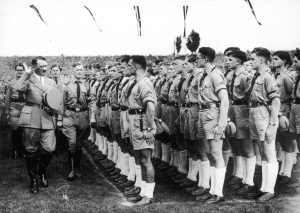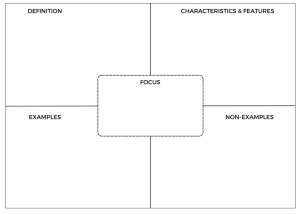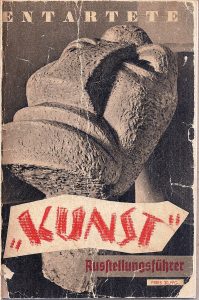29 Social and cultural change in Nazi Germany by Sarah Bishay
1. Film analysis: Swing Kids (1993) directed by Thomas Carter

Hitler inspiserer Hitlerjugend under partidagen i 1935, Author Unknown, Public Domain
| Curriculum context | VCE Modern History Unit 1: Change and Conflict, Area of Study 2: Social and Cultural Change (VCAA, 2020) |
| Historical context | How the Nazi government attempted to control, influence and resist political, social and cultural expression in the 1930s. |
| Historical thinking concepts | Exploring historical perspectives
Using sources as evidence |
| Learning intentions | To adopt a critical and objective lens when analysing historical perspectives, voices and narratives of society in the 1920s and 1930s.
To understand how the Nazi government controlled and influenced political, social and cultural expression. |
Activity
Introduction
Swing Kids (1993) Plot Summary: The film Swing Kids (1993) is set in the context of Nazi Germany before World War II. This film follows a group of rebellious young Germans who are captivated by their love of swing music and dance. Despite swing music being forbidden by the Nazis, their love for swing music grows and a secret underground dance club is formed. Amidst the backdrop of oppression, swing music becomes a form of resistance and self-expression (Oxford University Press, 2009). The story delves into the lives of Thomas and Peter, who are both torn between conformity and individuality in a society filled with fear, propaganda and control (Oxford University Press, 2009).
After viewing the film Swing Kids (1993), it is time to evaluate the historical value this film holds, and its reliability in depicting the social and cultural aspects of society in the 1920s and 1930s by focusing on the development and change of these aspects (VCAA, 2023c). This activity is designed to target your historical thinking concepts as you explore historical perspectives, evaluate sources and use these as evidence to “understand the ideas, beliefs and values held at the time“ (VCAA, 2023b)
Note for teachers: A legitimate copy of the film will need to be located, perhaps with the help of the school librarian. You might also be able to access the film through sites such as Hoopla, using your local library card.
A) Video Analysis
There are key issues, themes and experiences that the film Swing Kids (1993) depicts. As a class we will view the Do you want me to report you? scene and examine the perspectives of both Thomas and Peter. At this stage in the film, Thomas has become a full-time Nazi, as opposed to Peter who still loves and believes in the power of swing music. After you watch this scene, think, pair and share with the person next to you and consider the mindsets of both Thomas and Peter. Think about possible internal struggles, conformity, and moral values and beliefs.
B) Research Task
Historical events and individuals should not be oversimplified by labelling them as either right or wrong, or by categorising them as “goodies” or “baddies” (VCAA, 2023b). As you begin to “understand that people in the past often acted according to different moral frameworks to the ones we know today”, you will be able to “make informed judgments and better explain and evaluate the consequences of those events, understanding how people responded to changes brought to society” (VCAA, 2023b).
Below is a set of comprehension questions and resources for you to begin. By answering these questions, you will investigate and understand the diverse perspectives, voices and narratives of society in the 1920s and 1930s, whilst targeting your historical thinking concepts.
Explore the Holocaust Encyclopedia as it would be best suited to develop your responses to the comprehension questions below. The Holocaust Encyclopedia uses tags to link similar sources and content. Use keywords to search, some examples include Hitler youth, indoctrinating youth, music, culture, disabilities, ideology, etc.
Comprehension Questions (answer in full sentences):
- What is the Hitler Youth?
- What is the Nazi ideology?
- With reference to the Swing Kids (1993), explain how the Hitler Youth was used to indoctrinate youth to Nazi ideology (VCAA, 2023c).
- Resistance and conformity are two themes evident in the Swing Kids (1993) film. Choose one of these themes and analyse the different forms of resistance or conformity with reference to one or more specific scenes.
- Using the Frayer model template (DET, 2022) below, select a focus to evaluate from the film:
- German Swing Culture
- The practices of the Hitler Youth
- The treatment of people with disabilities in Nazi society
- Approved Nazi music

C) Extended Response
- Explain why the Swing Kids (1993) is OR is not reliable in depicting the social and cultural aspects of society in the 1920s and 1930s. Use evidence to develop your argument and justify your reasoning.
- Make 3 suggestions as to how the film director could improve the historical accuracy and reliability of the Swing Kids (1993).
References
Carter, T. (Director). (1993). Swing Kids. Hollywood Pictures.
Department of Education. (2021, September 13). Understanding history terms and concepts – The Frayer model. Victoria State Government. https://www.education.vic.gov.au/school/teachers/teachingresources/discipline/english/literacy/Pages/understanding-history-terms.aspx
El-Mecky, N. (2012, November 10). 6.1: Art in Nazi Germany [Image]. LibreTexts. Retrieved July 18, 2023, from https://human.libretexts.org/Courses/Lumen_Learning/Book%3A_Introduction_to_Art_Concepts_%28Lumen%29/06%3A_Art_History_%28The_Modern_West_and_Non-Western_Art%29/6.01%3A_Art_in_Nazi_Germany
Holocaust Encyclopedia. (n.d.) Search the Holocaust encyclopedia. https://encyclopedia.ushmm.org/en
Oxford University Press. (2009). Swing Kids. Higher Education Group. https://global.oup.com/us/companion.websites/playingnow/swingkids/
Victorian Curriculum and Assessment Authority (2023b). Characteristics of the study. https://www.vcaa.vic.edu.au/curriculum/vce/vce-study-designs/history/advice-for-teachers/Pages/CharacteristicsoftheStudy.aspx
Victorian Curriculum and Assessment Authority (2023c). Advice for teachers – History: Teaching and learning activities. Unit 1 Change and conflict – Area of study 2: Social and cultural change. https://www.vcaa.vic.edu.au/curriculum/vce/vce-study-designs/history/advice-for-teachers/Pages/TeachingandLearningActivities-Units1and2ModernHistory.aspx
VCAA. (2020). VCE Study Design: History 2022-2026. Victorian Curriculum and Assessment Authority. https://www.vcaa.vic.edu.au/curriculum/vce/vce-study-designs/history/Pages/index.aspx
2. Oppression vs. Resistance

Degenerate Art Exhibition Germany 1937 Guide Catalogue Brochure Cover published by the Reichspropagandaleitung, Amtsleitung Kultur 1937 (CC BY-SA 4.0)
| Curriculum context | VCE Modern History Unit 1: Change and Conflict, Area of Study 2: Social and Cultural Change (VCAA, 2020) |
| Historical context | Analysing why the Nazi government controlled cultural expression through art and propaganda to reinforce their cultural, social and political agendas. |
| Historical thinking concepts | Exploring historical perspectives
Using sources as evidence Cause and consequence |
| Learning intention | To understand forms of resistance in the 1920s and 1930s through music and art.
To analyse how the Nazi government used propaganda to reinforce their social, political and cultural agendas to tackle resistance. |
Introduction
In the above activity we focused on an overview of how the Nazi government attempted to control, influence and resist political, social and cultural expression in the 1930s, with a focus on the Swing Kids (1993) film. There are various ways individuals express their perspectives, voices and narratives. Some common forms of expression are through art, music and overall culture. In this lesson, we begin to analyse how, and why, the Nazi government controlled cultural expression through art, music and propaganda to reinforce their cultural, social and political agendas.
Below you will compare and contrast the difference between the 1920s and 1930s cultural expression through music and arts, and the Nazi concepts of degenerate music and arts. In doing so, you will further develop and refine your historical thinking skills by analysing sources and using these as evidence to discuss the cause and consequence of Nazi propaganda. Moreover, this will allow you to investigate the language and meaning in the context of Nazi Germany to better understand the ideas, beliefs and values that were held at the time (VCAA, 2023b).
A) Aryan Art vs. Degenerate Art
Propaganda is a powerful tool that is used to influence society. Throughout the 1920s and 1930s, the Nazi government adopted various propaganda tools to influence and resist cultural expression as they believed the ambiguity of modern art could endanger public security and order (United States Holocaust Memorial Museum [USHMM], 2020). The Nazi government claimed that modern art conspires to weaken German society and that only criminal minds were capable of such art (USHMM, 2020). In response, the Nazi government labelled this art “degenerate” (USHMM, 2020). Whilst any art that was not problematic was labelled “Aryan” art, such pieces reflected youth, power, tradition and superiority (El-Mecky, 2012).
Source 1: Using SCIM-C (Virginia Tech, 2004), contrast the catalogue covers of The 1937 Great Exhibition of German Art (left) and the Entartete Kunst (Degenerate Art) Exhibition (right) using the SCIM-C source analysis method (VCAA, 2023c):
SCIM-C
- S: Summarise
- C: Contextualise
- I: Inferring
- M: Monitoring
- C: Corroborating
Read this article to help you conduct your SCIM-C analysis: CLICK HERE: Nazi Art Policy (El-Mecky, 2012).
qanalyse the different types of art pieces that belonged to each exhibition. Consider why some were labelled “degenerate” and some “Aryan” art.
B) Swing Music vs. Nazi Approved Music
In the mid-1930s, swing jazz emerged from the United States and gained popularity worldwide, even in Nazi Germany (Fackler, 2000, para. 1). It became a trend in popular music as the world began to recover from economic depression. Despite discrimination against jazz and swing culture in the Third Reich, swing found an enthusiastic and dance-hungry audience (Fackler, 2000, para. 1). For young fans, swing music and dancing represented a way of life and created their own discrete youth culture. However, for the Nazi government, this posed a threat to their control over society (Fackler, 2000, para. 1).
Source 2: Watch this clip and answer the following questions: CLICK HERE: Nazi Germany: Swing Kids – Youth in Hitler’s Germany
- Describe what was happening at this time.
- Explain why the youth’s rebellious attitude made a mockery of Nazi control.
- Identify the characteristics used to describe swing culture. Whose perspective is this and why?
- To what extent did the Nazi government go to stop the youth from rebelling and how? What laws were put in place?
Source 3: Following this clip, visit this website and read about how the Nazi government adopted swing music as a tool for propaganda.
CLICK HERE: Charlie and His Orchestra
Consider the questions below to guide you in your comparative analysis:
- Who are Charlie and His Orchestra?
- Listen to the modified version of St Louis Blues (on the site).
- o Describe the views and beliefs in this song.
- o How did the Nazi government use swing music as propaganda?
- o What are the similarities and differences between the Nazi propaganda version and the type of music heard in the film Swing Kids (1993)?
- o How could propaganda through music influence society?
C) Art and Music under The Third Reich
The Nazi government imposed strict rules and controls over what could be enjoyed in terms of music and art, anything out of the norms of society was categorised as degenerate and inferior (McKee, 2000, para. 1).
Source 4: Compare the Entartete Kunst (Degenerate Art) catalogue cover and the Entartete Musik (Degenerate Music) and respond to the short answer questions.
Read through this short article to formulate and synthesise your answers: CLICK HERE: Art and Music under The Third Reich.
- Note down the literal and symbolic elements in the catalogue cover and the propaganda poster.
- Why were these created? Who were they created for?
- How does the artist “use language, words, symbols, gestures and colours to persuade the audience?” (VCAA, 2023b).
- What is the artist’s perspective and intention?
- What would the audience’s perspective be and why?
- Identify the underlying issue the Nazi government had with degenerate art and music and explain why.
References
Carter, T. (Director). (1993). Swing Kids. Hollywood Pictures.
El-Mecky, N. (2012, November 10). 6.1: Art in Nazi Germany [Image]. LibreTexts. Retrieved July 18, 2023, from https://human.libretexts.org/Courses/Lumen_Learning/Book%3A_Introduction_to_Art_Concepts_%28Lumen%29/06%3A_Art_History_%28The_Modern_West_and_Non-Western_Art%29/6.01%3A_Art_in_Nazi_Germany
El-Mecky, N. (2012, November 10). 6.1: Art in Nazi Germany. LibreTexts. https://human.libretexts.org/Courses/Lumen_Learning/Book%3A_Introduction_to_Art_Concepts_%28Lumen%29/06%3A_Art_History_%28The_Modern_West_and_Non-Western_Art%29/6.01%3A_Art_in_Nazi_Germany
Fackler, G. (2000). Swing kids behind barbed wire. Music and The Holocaust. https://holocaustmusic.ort.org/politics-and-propaganda/third-reich/swing-kids-behind-barbed-wire/
McKee, A. (2000). Art and music under the Third Reich: Entartete Kunst and Entartete Musik exhibitions. Music and The Holocaust. https://holocaustmusic.ort.org/politics-and-propaganda/third-reich/entartete-musik/
Petit, É. (2000). Charlie and his orchestra. Music and The Holocaust. https://holocaustmusic.ort.org/politics-and-propaganda/third-reich/charlie-and-his-orchestra/
Timelines TV [timelinesTV]. (2013, February 18). Nazi Germany – Swing kids – Youth in Hitler’s Germany N04c [Video]. YouTube. https://www.youtube.com/watch?v=J7awpjXrWls
United States Holocaust Memorial Museum. (2020, June 8). Degenerate art. Holocaust Encyclopedia. https://encyclopedia.ushmm.org/content/en/article/degenerate-art-1
Verlag, V. (1938). Entartete Musik [Image]. Wikipedia. Retrieved July 26, 2023, from https://en.wikipedia.org/wiki/Degenerate_music
VCAA (2023b). Characteristics of the study. Victorian Curriculum and Assessment Authority https://www.vcaa.vic.edu.au/curriculum/vce/vce-study-designs/history/advice-for-teachers/Pages/CharacteristicsoftheStudy.aspx
VCAA. (2020). VCE Study Design: History 2022-2026. Victorian Curriculum and Assessment Authority. https://www.vcaa.vic.edu.au/curriculum/vce/vce-study-designs/history/Pages/index.aspx
Virginia Tech (2004). SCIM-C: Historical inquiry. http://www.historicalinquiry.com

